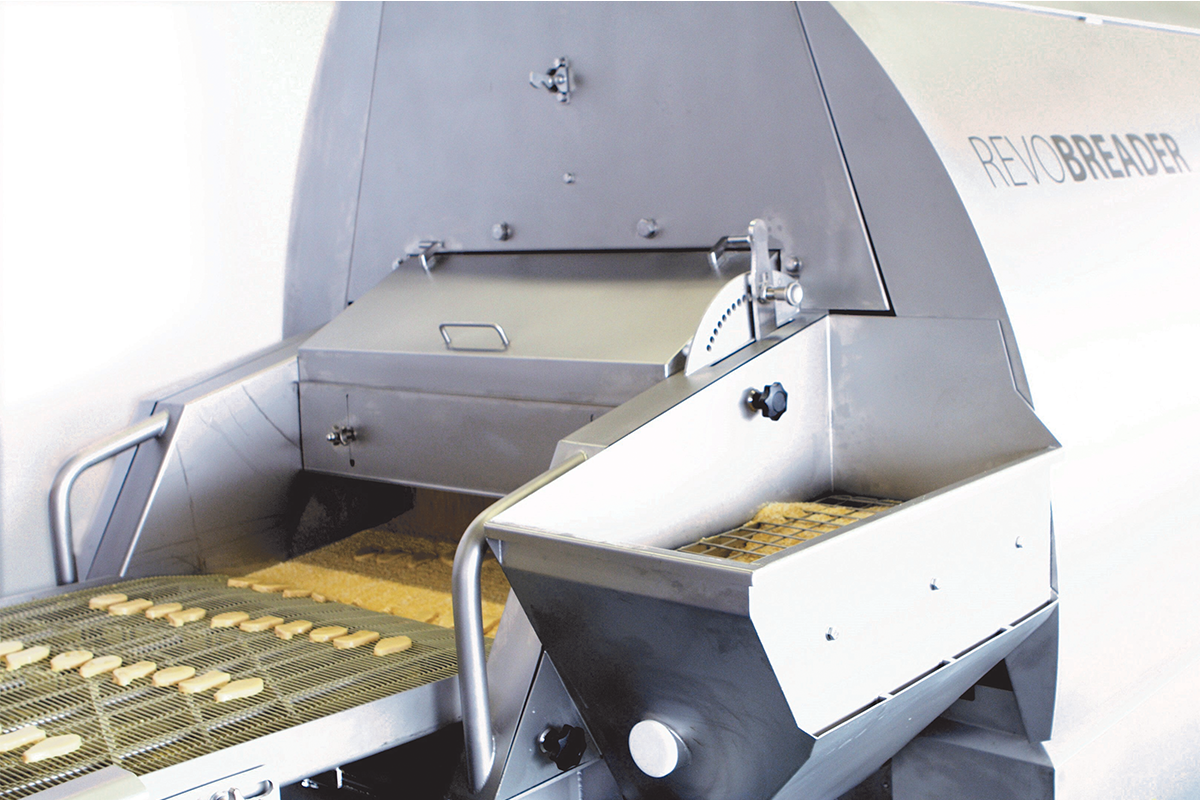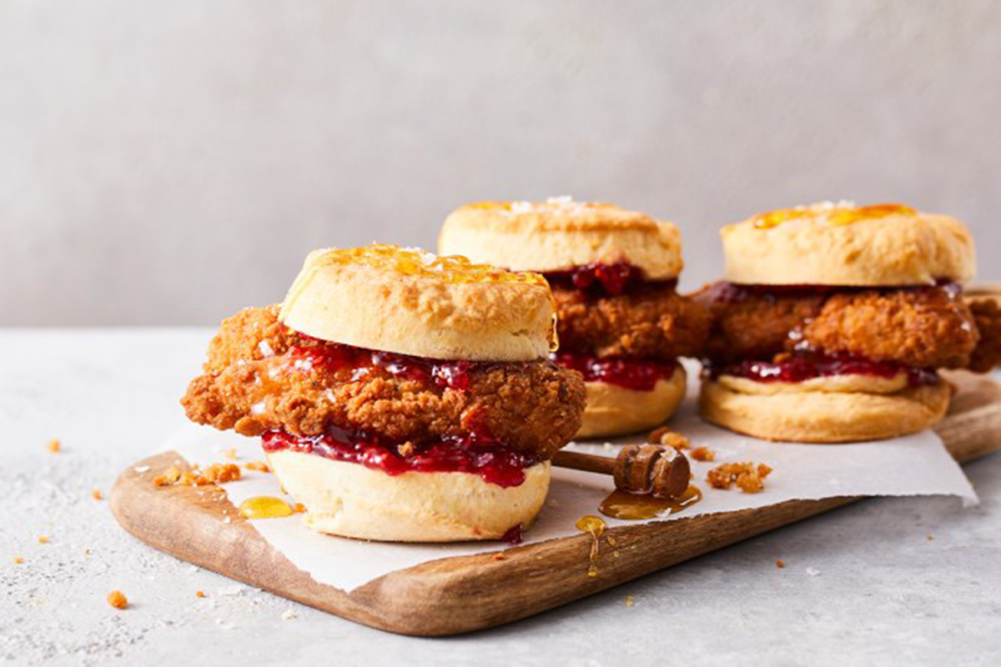The chicken sandwich wars that started a few years ago displayed how important creating craveable taste experiences is, with the flavor and texture key to meeting consumer wants and driving consumer loyalty.
Those consumer desires for new taste experiences have led to an enormous expansion in flavor variety launched in foodservice as well as a focus on delivering the best core profile.
“Today’s suppliers must be poised to not only deliver their solutions but be partners to processors and brands in understanding the operational challenges, application needs and how their solution needs to adjust to support in delivering on those needs,” said Kelly Heathington, senior business development director, taste and coatings into poultry, for Beloit, Wis.-based Kerry.
As an example, Kerry has an extensive portfolio of coatings, taste solutions, smoke, food protection and more that its application innovation experts use to support customers in overcoming their challenges in delivering great flavors for their consumers.
“Our application innovation experts leverage technology, science and culinary excellence to partner with customers in solving their technical problems,” Heathington said.
When it comes to breading systems, the pandemic brought about the need for labor saving operations, requiring fast changeovers with minimum loss of WIP, ingredients and production time. Tom Van Doorn, director of MP Equipment, Gainesville, Ga., noted flexibility is a big trend in today’s equipment.
“The ability to produce coated products with several different types of breading and finishes — flat, home-style, J-crumb, etc. — without moving different equipment in and out of the production line at the expense of production time,” he said.
Marloes ten Haaf, marketing manager for Lenexa, Kan.-based Marel, noted that with the pandemic now behind us, people are once again mingling and going out and quick-service restaurants are doing good business with chicken-based products such as nuggets and strips in ever greater demand.
“For suppliers of these products, priorities when choosing equipment systems are that they must be fast, flexible and save labor, which is now increasingly difficult to find,” he said. “They should make the best possible use of the incoming raw material, making safe, consistently uniform products of the highest quality and yield.”
Philip Hurwitz, director of sales for Nothum Food Processing Systems, Springfield, Mo., has seen an upturn in the desire for flexible lines that can produce whole muscle breaded products, formed products and tempura.
“As producers compete for business, they need to accommodate the market demand,” he said. “Currently, there is an increased demand for a wide range of breading pickups on parfried items — this can vary from a light coating to a heavy fritter.”
New and improved
MP, which makes formers, electric and hydraulically driven breaders, batter mixers, batter applicators and fryers, has developed new, simpler, more gentle ways to move the breading through the breaders and onto the product.
“We simplified the overall design to eliminate motors, gearboxes, augers and electronics,” Van Doorn said. “We also simplified operation by automating many previously manual adjustments and employing state of the art mechanical and electronic technology to eliminate the ‘tribal knowledge’ requirement to achieve mastery of operation.”
Upcoming, MP is introducing a new series of breaders, which he noted will set new records for ease of operation, reliability, labor and breading savings, to name a few of the strengths.
Nothum offers the SuperFlex, which is capable of producing a traditional flat breaded texture, a homestyle appearance with a drum, and several other textured appearances with a triple flip or hand toss insert(s).
“Additionally, the Nothum BatterPro can accommodate thin to thick batters as well as tempura, with an optional water, hot sauce or beer liquid,” Hurwitz said. “Of course, the ProTherm fryer is also capable of handling a wide range of products that come from the SuperFlex and BatterPro.”
Kerry’s coating capabilities include complete coating systems, pre-dusts, batters, and breaders. Among areas of expertise include tempura-style, cracker meal, Japanese and Panko breadcrumbs, American breadcrumb and novel breaders.
Heathington noted managing food safety and quality processes needs to continue to be a priority when developing coating systems.
“We continue to invest in industry-leading technology advancement in order to deliver enhanced quality control manufacturing systems and safe ingredients,” she said.
Marel offers complete whole line solutions from inspection of the raw material right through to freezing of the finished product.
“We have a range of capacities right up to 40-inch lines to help high-volume producers meet demand from the largest QSR chains,” ten Haaf said. “Bespoke Innova software manages recipes, provides full traceability and supplies comprehensive real-time data on performance, ensuring that customer orders are always met efficiently and safely.”
Most notably, the company’s RevoBreader breading machine is in fact three machines in one single enclosure.
“It is a drum breading machine, a flatbed breading machine and can also be used as a pre-dusting machine,” ten Haaf said. “In drum mode, RevoBreader can be used to make products with that genuine flaky home-made look. A spreading wheel at RevoBreader’s outfeed distributes product evenly across the belt to allow correct infeed into the next processing step.
“In flatbed mode, Revobreader applies crumb evenly to all sides of the product to be coated. Change-over from one mode to the other is extremely quick and does not involve removing components.”
 A spreading wheel at RevoBreader's outfeed distributes product evenly across the belt to allow correct infeed into the next processing step. (Source: Marel)
A spreading wheel at RevoBreader's outfeed distributes product evenly across the belt to allow correct infeed into the next processing step. (Source: Marel)
Caring for equipment
With more convenience products being eaten, further processors are having to work faster and longer. Equipment should therefore be super-reliable, easy to clean and require minimal maintenance. Thankfully, today’s equipment doesn’t require as much maintenance as in the past, with product transport belts being the main source of required maintenance.
“MP has improved belt life by redesigning our belt paths to be simpler and shorter,” Van Doorn said. “Bearing technology has steadily improved, reducing further the need to lubricate hard-to-get-to bearings. New metallurgy increases the life of wear items and consumables.”
All Nothum equipment uses electrical components that technicians know and/or have prior experience with using.
“This ensures an easy training curve when purchasing Nothum equipment,” Hurwitz said. “We also recommend a weekly PM procedure to check all mechanical components. This guarantees that the production line has the highest chance for success on a weekly basis.”
Looking ahead
Over the next few years, industry insiders expect consumption of breaded proteins will increase whilst labor will become ever harder to find.
“Automation is therefore the answer,” ten Haaf said. “There is an exciting future for nugget production equipment.”
Hurwitz noted labor will continue to become more scarce and less skilled, so it is imperative that future equipment is automated and intuitive to reduce the need for human interaction and error.
“Additionally, it is important for equipment to provide a high yielding and high quality product; all while reducing the amount of waste,” he said. “Every producer is fighting to earn the same business, so any competitive advantage they can gain from their equipment will help them succeed.”



